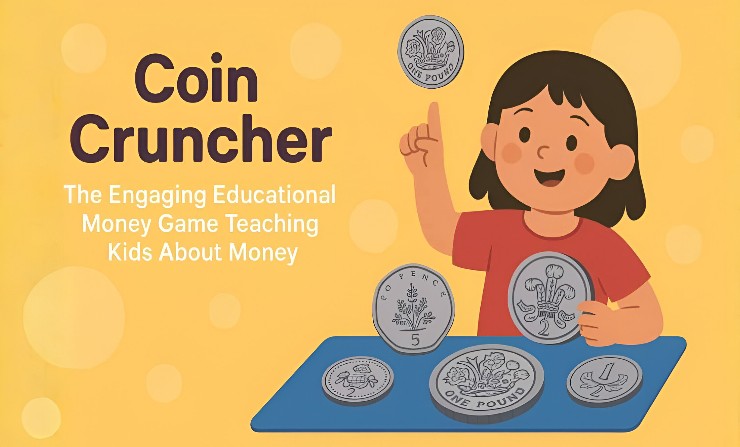Coin Cruncher: The Engaging Educational Game Teaching Kids About Money

Understanding the value of money is one of the most important life skills every child must learn. Yet, traditional methods such as paper worksheets or simple counting exercises often fail to capture a child’s interest. This is where Coin Cruncher, an interactive educational game created by NatWest Thrive, steps in to revolutionise early financial education. Designed for children aged five to seven, Coin Cruncher turns the challenging concept of money into an engaging, fun, and memorable learning experience. It encourages young learners to recognise coins, understand their values, and practise making different totals—all while having fun through colourful visuals and interactive challenges.
Coin Cruncher is not merely a game; it is a thoughtfully developed digital learning tool that combines entertainment with essential numeracy skills. By turning money lessons into an interactive experience, it helps children grasp the basics of addition, value comparison, and financial reasoning in a stress-free environment.
What Is Coin Cruncher?
Coin Cruncher is an online educational tool developed as part of NatWest’s Thrive learning resources. It is specifically created to help young children understand how money works through games and activities such as “How Much?” and “Make the Total.” These interactive challenges encourage children to count, add, and match coins to given totals, improving both their numerical accuracy and their ability to identify different coin denominations.
The game is primarily aimed at pupils in Key Stage 1, the age range where children begin developing a foundational understanding of mathematics. Coin Cruncher uses colourful graphics, cheerful sound effects, and simple instructions to make the learning process engaging and enjoyable. The intuitive design ensures that even children with minimal digital experience can navigate the game easily.
The Educational Purpose Behind Coin Cruncher
The purpose of Coin Cruncher extends beyond teaching coin values. It aims to cultivate financial awareness and mathematical confidence at an early age. Many children find numbers abstract or intimidating, but when they associate them with something tangible—like coins—they begin to understand how maths applies to the real world.
Through repeated play, Coin Cruncher strengthens the following key learning areas:
- Numerical Recognition – Children learn to identify different coins by their appearance, colour, and size.
- Addition and Counting Skills – They practise adding coins to reach specific amounts.
- Value Comparison – The game introduces the concept of greater and smaller amounts using familiar money examples.
- Decision-Making – Players must decide which combinations of coins will achieve the desired total.
- Financial Responsibility – The game subtly introduces the idea that every coin holds value and contributes to saving and spending decisions.
This multi-layered educational structure transforms Coin Cruncher from a simple game into a foundation for future financial literacy.
How Coin Cruncher Works
Coin Cruncher is divided into short, fun-filled challenges that gradually increase in difficulty. Children can start with simple recognition activities and progress to more complex counting and addition tasks.
In the “How Much” activity, players must determine the total value of a group of coins displayed on the screen. This strengthens their ability to add small numbers mentally. In the “Make the Total” game, children are given a target amount and must select the correct combination of coins to reach it. This activity encourages experimentation, problem-solving, and understanding of different ways to form the same total.
Each correct answer is met with positive reinforcement such as cheerful sounds and animations, motivating children to continue playing. Mistakes are corrected instantly, allowing children to learn through gentle feedback rather than pressure or frustration.
The short playtime (around five to ten minutes per session) ensures that learning remains focused and effective. Teachers or parents can incorporate it into a daily learning schedule without overwhelming the child.
Why Coin Cruncher Is So Effective
The effectiveness of Coin Cruncher lies in its combination of interactive design, instant feedback, and real-world context. Children learn better when they can connect theory to practical situations. By using familiar objects like coins, Coin Cruncher bridges the gap between classroom maths and everyday life.
Another strength is that the game is self-paced. Children can replay levels as many times as they wish, gaining confidence with each attempt. This flexibility makes it suitable for both classroom use and home learning. Teachers often use it as a reinforcement activity during maths lessons, while parents use it as a fun educational pastime.
Research in early childhood education supports the use of gamified learning. Games like Coin Cruncher stimulate critical thinking, problem-solving, and memory retention—skills that are vital for academic success in later years.
The Broader Learning Ecosystem
Coin Cruncher is part of the NatWest Thrive initiative, a larger educational platform that includes various financial literacy resources for children and young adults. It aligns with the MoneySense curriculum, which focuses on practical financial education.
Beyond Coin Cruncher, other games and resources on the platform teach topics such as saving money, budgeting, and understanding where money comes from. The combination of these resources helps children gradually progress from simple money recognition to understanding more advanced financial concepts.
In the MoneySense for tots and teens programme, Coin Cruncher is highlighted as one of the best starting points for early learners. It lays the groundwork for responsible money habits and an appreciation of financial decision-making.
Benefits for Teachers and Parents
Coin Cruncher provides numerous benefits for both teachers and parents seeking effective educational tools:
- Curriculum Alignment: It fits perfectly with UK Key Stage 1 learning objectives related to counting, addition, and identifying coins.
- Ease of Access: As an online tool, it can be accessed from tablets, laptops, and classroom computers without complicated setup.
- Engagement: The colourful interface and interactive features hold children’s attention better than static worksheets.
- Progressive Learning: Difficulty increases naturally, ensuring that children remain challenged but not frustrated.
- Independent Learning: Children can play without constant adult supervision, promoting autonomy and confidence.
Teachers often use it during mathematics lessons as a warm-up or revision activity, while parents find it useful for reinforcing what their children have learned at school.
Skills Developed Through Coin Cruncher
Coin Cruncher supports the development of both cognitive and emotional skills.
1. Mathematical Understanding
Children practise recognising numbers and coin denominations, building strong mental calculation skills.
2. Problem-Solving
Each round presents a new challenge that encourages logical thinking and experimentation.
3. Visual Learning
The colourful design helps visual learners remember coin values more easily.
4. Perseverance and Confidence
Because the game allows multiple attempts, children learn persistence and resilience when solving problems.
5. Real-Life Application
Children begin to relate the concept of money to real-world situations, such as shopping or saving.
Why Early Financial Education Matters
Teaching children about money at a young age prepares them for responsible financial habits later in life. When children understand that money has value, they become more mindful about spending and saving as they grow older. Coin Cruncher introduces this awareness naturally, through play rather than lecture.
Studies have shown that early exposure to financial concepts leads to better money management skills in adulthood. Tools like Coin Cruncher are vital in making financial education accessible, fun, and memorable.
The Future of Digital Learning Tools
Coin Cruncher represents the growing trend of gamified learning in education. As technology continues to evolve, more schools are incorporating interactive tools into their lessons. The use of such games not only enhances engagement but also improves retention rates and student motivation.
In the future, we may see versions of Coin Cruncher that adapt to different currencies worldwide, teaching children about global money systems and exchange rates. The concept can also expand into advanced levels for older students, covering budgeting, online safety in spending, and financial decision-making.
Conclusion
Coin Cruncher is far more than a simple counting game; it is an essential educational tool that bridges the gap between mathematical learning and real-world understanding. By making money concepts tangible and enjoyable, it helps children build both numeracy skills and financial confidence from an early age.
Its structured yet playful design makes it ideal for classrooms and homes alike, offering teachers and parents a powerful way to introduce essential life skills. In a world where financial awareness is increasingly important, Coin Cruncher stands as a shining example of how technology can turn learning into a joyful and lasting experience.



